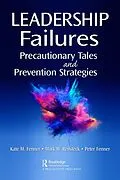Humans make mistakes. Many of us lose career ascendency or risk destroying our institutions by doubling down on or ignoring outcomes of our own poor decisions.
Good leaders learn and teach from their errors. Professions are strengthened. Institutions thrive. Careers grow.
Through real-life stories that focus on senior/board leadership from multiple walks of life, and brief discussions of significant attributes, readers will be challenged to diagnose and turn missteps into positive growth experiences.
The authors of this book have had extensive careers in public and private, for-profit and not-for-profit settings, and in independent and government-sponsored consulting, development, academic, and clinical environments. Without having any single leadership paradigm to push, they raise questions about outcomes for institutions that are affected and individual career paths.
Their cautionary tales ask readers to think through "next steps" or prevent the need to get there; hence, this is an ideal extra-assignment book in graduate management courses and for managers seeking to work their way up toward higher leadership roles. Board members also can learn from its non-industry-specific target readership.
Autorentext
Kate M. Fenner, RN, PhD--Having immersed herself in issues, innovations, and solutions relevant to today's dynamic business, healthcare, and higher educational organizations, Kate has the rare ability to problem-solve with humor and deep analysis, communicating at all levels of an organization-from frontline staff to the Board--even when their goals seem unaligned. Aside her former CEO and Managing Director roles in the consulting world, where she used her talents to help organizational clients meet clinical, financial, and cultural goals, she has also held leadership roles for over a quarter century, including being a university Professor, Dean of Nursing, and Vice President, while also serving on national and state boards and committees focused on the advancement and support of education. She has applied proven leadership and development strategies to a wide range of hospitals, health systems, and academic medical centers, providing clients with creative, effective solutions to their most pressing organizational concerns, particularly focusing on leadership, organizational optimization, performance improvement, and regulatory compliance. A model mentor for graduate students and a regular keynoter throughout the country, Kate authored a leading college text on law and ethics in healthcare, and wrote numerous journal papers and blogs, and co-authored other professional works.
Peter Fenner, PhD--Peter has decades of professional leadership experience within healthcare, higher education, corporate and community environments. Heading various nationally funded research and organizational projects was a good background for later corporate leadership roles that also allowed him deep involvement in committees and boards of international, national, state, regional and local associations. With early publications as a scientist, he mentored many doctoral learners and published dozens of journal articles and books as well a similar number of up to book-length proprietary reports. As Academic Vice Chancellor within a Big-Ten System institution, a long-term Dean of Environmental and Applied Sciences, also with faculty roles in regional, state and Ivy-league institutions, and having served as Executive Director of one of the U.S. College Commissions, and a corporate consulting leader, his abilities to work within a realm of competing and diverse interests allowed successful negotiation of difficult pathways. He has acted as lead consultant on projects involving communication systems, information systems/technology optimization, strategic planning, and management development initiatives. Current writing reflects his interest in leadership, linguistics, general semantics, and research methodologies.
Mark W. Reifsteck, MHA, LFACHE--Mark has over 30 years of consistent leadership achievement in complex, values-based organizations and boutique consulting firms. His record includes excellent working relations with physicians, highlighting his skills in performance improvement methods to achieve strategic and operational results-especially where oppositional contentiousness had been entrenched. In not-for-profit hospital administration he had increasing responsibilities starting at a 150-bed acute care general hospital, through assignments as SVP and COO at a top-10 integrated healthcare system, to Division President and Chief Executive at a 15-hospital system with $1.7 billion in net revenues, 14,000 employees and 4000 physicians. He focused on improvements in market share, financial results, contracting, and clinical outcomes. In the for-profit sector, he worked through becoming Managing Director and President responsible for considerable corporate growth and systems improvements, while implementing improvements dedicated to activating the potential of healthcare organizations around the country. He is currently engaged in voluntary board work and other activities to advance his interests in philanthropy and healthcare innovation and constructive disruption. His publications reflect his awareness of industry changes and relevance of risk-taking.
Inhalt
Preface
- Three Envelopes: An Important Opening Parable
- Is This Book for You? Essential Elements
- Prevention and Damage Control
Introduction: Our View
- Why Us? .
- Book Organization & How to Use .
Section 1: Stories
Chapter 1: Vignettes About Failures
Vignette 1: Well-prepared for the Wrong Role
Vignette 2: Counter-cultural Leadership
Vignette 3: Well Qualified, But Lazy
Vignette 4: Sick Organization Syndrome (SOS)
Vignette 5: Large and In Charge
Vignette 6: Weak Moral Compass
Vignette 7: You Can Stay Too Long
Vignette 8: Symbols & Behaviors Communicate More than Words
Vignette 9: A Single Source of Truth Needs to be Verified
Vignette 10: Temper Tantrums Are for Two-year-olds
Vignette 11: Rip off the Bandage
Vignette 12: Keep the Personal Away from the Professional
Vignette 13: Leader's Mind, But Not Brain, Is Lost
Vignette 14: Family Business or Business of the Family?
Vignette 15: Bureaucratic Success, Mission Leadership Failure
Vignette 16: Leadership Failure Cascade
Vignette 17: Boards Bruise the Business
Vignette 18: Don't Confuse Activity With Productivity
Vignette 19: Small Intervention But Huge Impact
Vignette 20: The No-bell Prize
Chapter 2: Essentials for Success
Attribute 1: Honesty/Integrity
Attribute 2: Self-Awareness
Attribute 3: Emotional Maturity
Attribute 4: Communicator
Attribute 5: Decisiveness
Attribute 6: Intelligence
Attribute 7: Resilience
Section 2: And Now What?
Chapter 3: Planning for Orderly Organizational Succession
Chapter 4: Modeling Career Growth as a Part of Succession
Chapter 5: Reframing for the Future
Chapter 6: The Final Admonition
APPENDICES: Tracking Matrix
